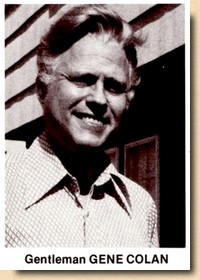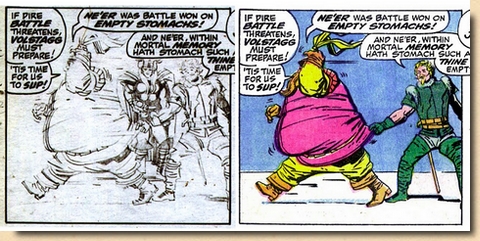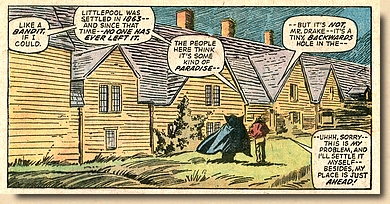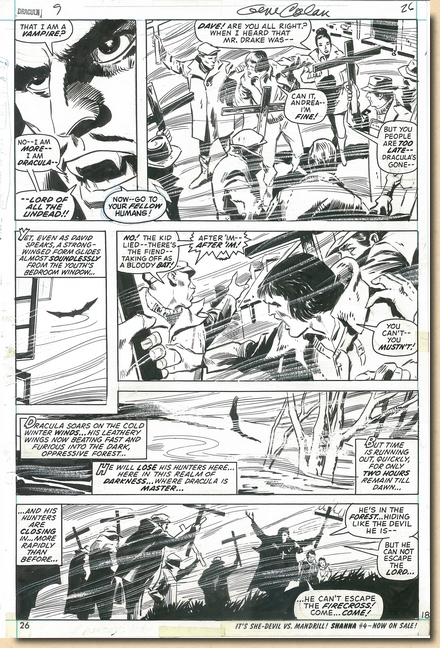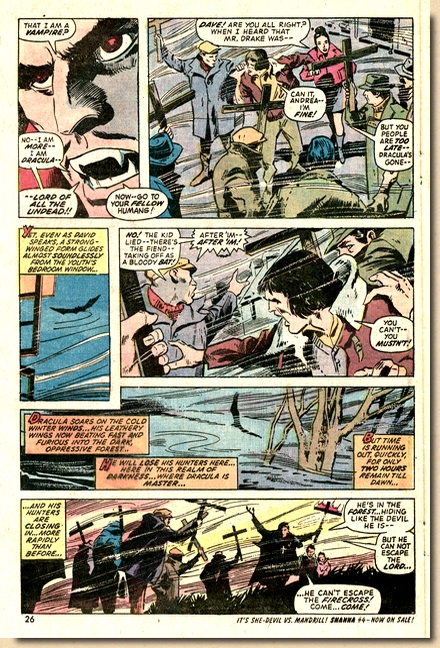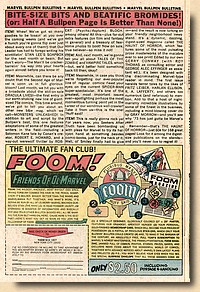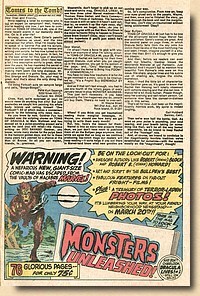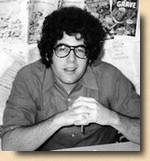|
 |
|
 SPOTLIGHT
ON SPOTLIGHT
ON
TOMB
OF DRACULA #9
(JUNE
1973)
|
|
|
|
| |
|
| |
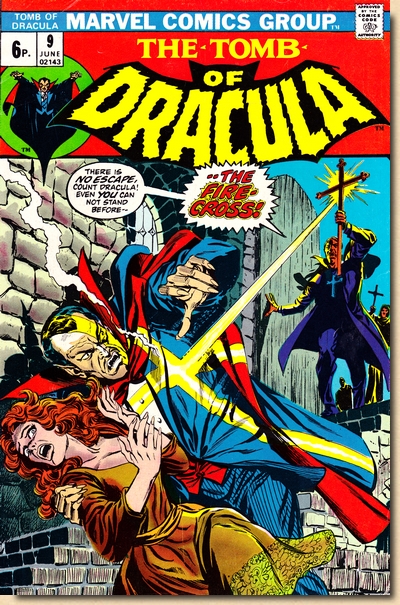
|
|
"Death
From The Sea!"
(20 pages)
Story
- Marv Wolfman
Art - Gene Colan
Inks - Vince Coletta
Colours - Glynis Wein
Lettering - Artie Simek
Editor - Roy Thomas
Cover - Gil Kane (pencils), Tom Palmer
(inks)
On sale 20 March
1973

was Marvel's
most popular and successful ongoing
horror title of the 1970s, weaving an
ongoing saga that plotted the vampire
count against a group of vampire hunters.
It was vividly brought to life by Marv
Wolfman's gripping multi-layer
storytelling and Gene Colan's moody
cinematographic artwork.
The overall
result harked back to the classic vampire
stories but also added new momentum to
the theme. Marvel's Tomb of Dracula
was an outstanding contribution to the
genre, a classic in its own right, and
the jewel in the crown of Marvel's Bronze
Age horror. It remains a fan favourite to
this day.
|
|
|
| |

|
| |
|
| |
SYNOPSIS
! SPOILER ALERT !
When a fisherman pulls out
a body from the sea, the locals decide to take
him to the local church at Littlepool - unaware
that the body they believe to be dead is actually
Dracula. Once inside the church, the Lord of Vampires regains
consciousness and is horrified only to find
himself inside a church, instantly feeling
intense physical pain induced by the many
crucifixes present. As he bolts out of the
church, Father Williams and the locals are both
stunned and shocked to find that the man they
pulled from the water clearly was not dead.
Dracula himself ponders on the events that
caused him ending up in the water, and remembers
how after leaving the dead body of Heinrich
Motte, a doctor-turned-vampire who gave him a
complete blood transfusion (in Tomb Of Dracula #8) to
counteract the effect of one of Quincey Harker's
poisoned arrows from a previous encounter, the
weakened Lord of Vampires was then beaten up by
a
group of bikers who just dumped his body in the
sea.
Relating a version of this
story that doesn't betray his true nature,
Dracula introduces himself to Father William as
"Mr. Drake". With no trains running for
a few days, Dracula decides to rest up and get
well, and accepts an offer to stay with a young
man named David and his mother. But rather than
catching a good night's sleep, as soon as night
falls Dracula is on the prowl for fresh blood.
|
|
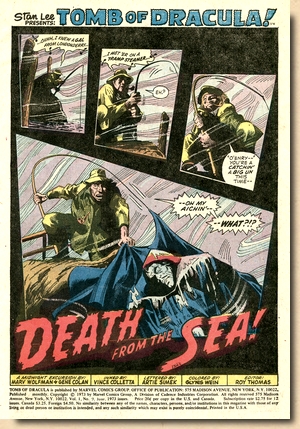 |
|
| |
| The curse of the vampire hits Littlepool quickly and
with a vengeance, as Dracula's victim of the night, the
local pub lady named Gladys, herself turns into a vampire
and takes a first victim, a pub regular named Corker -
who, now also a vampire, attempts to feed on David's
girlfriend Andrea. Meanwhile, in
London, with no leads on Dracula's location Quincy Harker
and his vampire hunters spend their time training when
Quincy suddenly gets a phone call which has him leaving
immediately.
Back in Littlepool, Dracula orders
Gladys and Corker to cease their attacks and leave. But
now Father William, who has witnessed this scene, sees
Dracula for what he really is, and gathers the town folk
to destroy Dracula. As the crowd gathers outside David's
home, they successfully track down Gladys and Corker and
stake them, but the Lord of Vampires is ultimately able
to escape by flying off into the misty night air.
|
| |
REVIEW & ANALYSIS
|
| |
| According to Roy Thomas, Tomb
of Dracula was a solid seller for most of its run
(Cooke, 2001), and Marv Wolfman and Gene Colan steadily
progressed on the title, from being two enthusiastic
individuals working together, to becoming an actual team
where mutual understanding and a shared perception
created results not otherwise possible. The series just
kept getting better and better, until it arguably reached
its prime for a period running from April 1974 to August
1975 over a sequence of 17 issues, in Tomb of Dracula
#19-35. |
| |

Marv
Wolfman in 1975
|
|
Marvin
"Marv" Wolfman (*1946) had started
working for the comic book industry in 1968 with
DC, yet he was still only 26 when he took over the scripting of Tomb
Of Dracula #7 for the March 1973 publication
schedule. With Wolfman at the reins, Marvel's
take on Dracula became a cleverly conceived and
superbly balanced piece of fiction.
"I'd never
seen a Dracula movie at that point, but I'd
read the novel, and I loved the novel (...)
Dracula himself was really a force more than
a presence because he's only in 80 or
something pages of a 500 pages novel, so the
attitude of the original book was more on the
people who are hunting him and the effects of
evil on them (...) Using that as the template
for the entire series it seemed to me that
this was an ideal concept to try and do more
realistic comics, to try and break out of the
comics for 11 year olds (...) I really wanted
to try to write something that was starting
to appeal to my age."
(Marv Wolfman in
Siuntres, 2006)
|
|
| |
| Tomb of Dracula #9 is
only Wolfman's third issue, and the most interesting
aspect of this issue, which concentrates almost entirely
on Dracula, is Wolfman's portrayal of the vampire count.
He obviously wanted to add complexity to the leading
character of the series, and hindsight has proven the
worth of this approach. Dracula is seen to show respect
in his interaction with David, even offering the young
local protection after what he has done to help him
escape from the villagers. In his portrayal of Dracula, Wolfman was
actually more concerned with the possibly remaining human
traits in the vampire count's personality than Bram
Stoker's novel had been - not the least, of course,
because Wolfman was not writing a single publication, but
a serialized narrative.
"[Dracula]
was the protagonist, but he was never the hero (...)
that was the trick. If you just saw this guy as a
(...) one-dimensional villain - as was the standard
at the time [in comic books] - there would be no way
to keep the series going. This book was called
"Tomb of Dracula", it wasn't called
"Tomb of Rachel van Helsing" or "The
Vampire Hunters" or something like that, so
Dracula had to become a real character (...) [there
had to be] some features about him, some things that
still reached back to when he was human." (Comic Geek Speak, 2005)
|
| Throughout
the course of Tomb of Dracula, these
remnants of Dracula's past as a human being - not
a vampire - would float (or sometimes even erupt)
to the surface of his twisted personality. He
would at times prove to be far from completely
free and devoid of human feelings such as pity,
love or even nostalgia - quite unlike what one
would come to expect from the overlord of the
undead. And when the series finally came
to an end, Quincy Harker admonishes the readers
in the last phrase of issue #70 - after having
destroyed Dracula - not to be forgetful of the
fact that, after all and foremost, Dracula was -
a man.
|
|
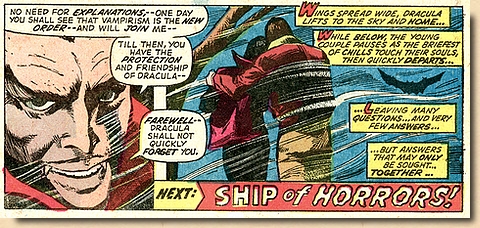 |
|
| |
| Having
built up a steady increase in sales, Tomb of Dracula changed
from bi-monthly to monthly publication with issue #9.
Readers really liked how everything was embedded in an
arc of overall continuity and plot suspense, and
Wolfman's introduction of aspects of moral philosophy,
along with portraying all characters involved (including
Dracula) as self-conflicting and sometimes even outright
self-contradicting personalities, gave Tomb Of
Dracula a maturity other comic book titles never
even got close to. |
| |
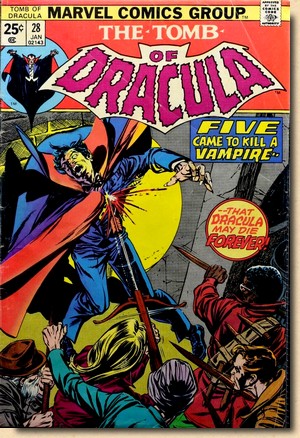
The entire
group of vampire hunters features on the Gil Kane
cover for Tomb of Dracula #28 (January
1975)
|
|
Fighting
the Lord of Vampires in Tomb of Dracula
was a team effort, just as it had been in
Stoker's novel. Having a group of "vampire
hunters" as antipodes to Dracula's actions
and schemes of world domination was presented so
well that it became an important element of the
ongoing saga and contributed in a very essential
way to the success of Tomb of Dracula.
Just as quintessential was
another direct connection to the literary source
that Wolfman established by way of the
introduction of the persona of Quincy Harker, in Tomb of Dracula #7.
Harker - who was only
introduced on the final page of Stoker's original
novel as a newly born baby - is now an elderly
man bound to a wheelchair; however, he has used
scientific means and sophisticated machinery to
hunt down vampires for the past sixty years after
having been trained by Abraham van Helsing
himself. He is the driving force behind the group
of vampire hunters, which includes Dracula's
descendant Frank Drake, Rachel van Helsing,
Indian mute Taj Nital, and "daywalker
vampire" Blade.
Within
this framework, Wolfman's conceptual ideas for
breaking out of established comic book routines
proved to be simply perfect, and very soon the
title found itself outside of the commonly
defined and charted corners not just of the
Marvel Universe, but the entire comic publishing
business.
"This was
the first time anything like this had been
done. I was fighting the Comics Code every
single month. We were just stretching - for
the first time - out of standard
comics." (Marv Wolfman in
Comic Geek Speak, 2005)
|
|
| Unlike
Wolfman, Gene Colan (1926-2011), nicknamed both "Gentleman"
and "the Dean" by Stan Lee,
worked on Tomb of Dracula right from the start,
and he would stay on the book throughout its entire run -
after having literally fought for this assignment from
Stan Lee |









